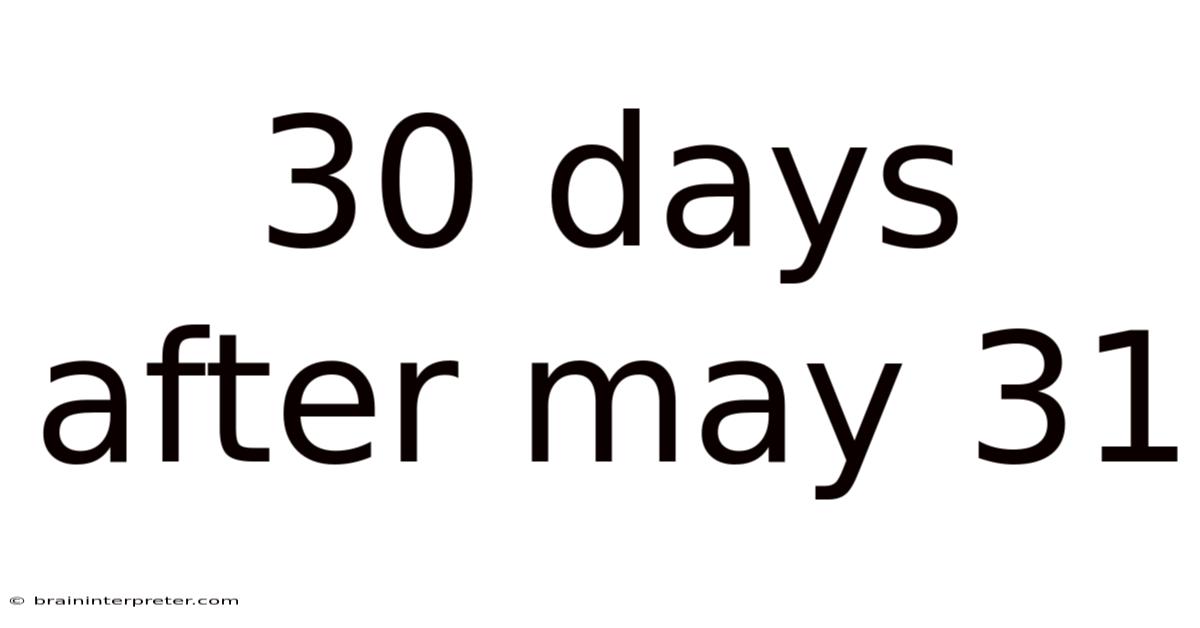30 Days After May 31
braininterpreter
Sep 23, 2025 · 4 min read

Table of Contents
30 Days After May 31st: Exploring the Implications of Time and Dates
The seemingly simple question, "What date is 30 days after May 31st?" actually opens a fascinating exploration of calendars, timekeeping, and the practical implications of date calculations. This article delves into the answer, exploring the methodology behind such calculations, the cultural significance of dates, and the various ways we perceive and utilize time in our daily lives. Understanding date calculations isn't just about knowing the answer; it's about comprehending the underlying systems and their impact.
Understanding the Calendar System
Before we can calculate the date 30 days after May 31st, it's crucial to understand the Gregorian calendar, the system most of the world uses. This calendar is a solar calendar, meaning it's based on the Earth's revolution around the sun. It features 12 months of varying lengths, with February having either 28 or 29 days depending on whether it's a leap year. Leap years occur every four years, except for years divisible by 100 but not by 400. This complexity is why simple addition doesn't always work when calculating dates.
The Gregorian calendar's structure is the foundation for our date calculations. Each month has a specific number of days, and understanding this is vital. Simply adding 30 to the day number of May 31st won't provide the correct answer. Instead, we need to account for the number of days in each month that passes.
Calculating the Date: A Step-by-Step Approach
To determine the date 30 days after May 31st, we'll break the calculation down step-by-step:
-
Starting Point: Our starting date is May 31st.
-
Days Remaining in May: May has 31 days. Since we're starting on the 31st, there are zero days remaining in May.
-
Moving to June: We need to account for the remaining 30 days. June has 30 days.
-
The Final Calculation: Since we have 30 days to account for and June has 30 days, the date 30 days after May 31st is June 30th.
Beyond Simple Calculations: The Nuances of Time
While calculating 30 days after May 31st might seem straightforward, the concept of time itself is far more nuanced. Our perception of time is subjective and culturally influenced. What constitutes a "day" can vary depending on the context. For instance:
-
Civil Day: A civil day runs from midnight to midnight, commonly used for scheduling and daily routines.
-
Astronomical Day: An astronomical day runs from noon to noon, often used in astronomy and related fields.
-
Cultural Significance: Specific days hold cultural significance across different societies. Religious holidays, national celebrations, and historical events are all linked to specific dates, enriching our understanding of time's passage.
The Importance of Accurate Date Calculation
Accurate date calculation has far-reaching implications across numerous aspects of life:
-
Business and Finance: Meeting deadlines, calculating interest, and tracking financial transactions all require precise date calculations.
-
Legal and Contractual Agreements: Contracts often specify deadlines and terms based on specific dates, making accurate calculations essential for legal compliance.
-
Scientific Research: Scientific research frequently involves tracking data over time, necessitating careful and accurate date recording and analysis.
-
Healthcare and Medicine: Medical records, treatment schedules, and drug dosages all rely heavily on accurate date and time information.
-
Travel and Logistics: Planning journeys, scheduling transportation, and coordinating logistics depend on precise date and time calculations.
Frequently Asked Questions (FAQs)
Q: What if I needed to calculate 31 days after May 31st?
A: Adding 31 days to May 31st would take us into July. June has 30 days, leaving one day remaining. Therefore, 31 days after May 31st would be July 1st.
Q: How do leap years affect date calculations?
A: Leap years add an extra day (February 29th) to the calendar. If the calculation spans a leap year, this extra day needs to be accounted for. For example, calculating 366 days after a date would involve considering whether a leap year is included within that period.
Q: Are there any online tools to help with date calculations?
A: While simple calculations like this can be done manually, various online date calculators and calendar applications are available that can assist with more complex date calculations, including adding or subtracting days, weeks, or months.
Q: Why is understanding the calendar system important?
A: Understanding the calendar system is essential for effective organization, planning, and communication. It's the foundation for scheduling, setting deadlines, and coordinating activities across various aspects of our lives.
Conclusion: The Power of Precision in Timekeeping
The seemingly simple question of determining the date 30 days after May 31st opens the door to a deeper understanding of the calendar system, the complexities of timekeeping, and the wide-ranging implications of accurate date calculations. From personal scheduling to large-scale logistical planning, precision in timekeeping is crucial. While technology offers tools to aid in these calculations, a fundamental grasp of the principles remains essential for anyone who seeks to navigate the complexities of dates and timelines effectively. The ability to accurately calculate dates, understand the intricacies of calendars, and appreciate the cultural nuances associated with specific dates is a valuable skill with applications across various domains of life. It underscores the importance of appreciating the systems that govern our lives and the ways in which we interact with the ever-flowing river of time.
Latest Posts
Latest Posts
-
10454 Sq Ft To Acres
Sep 23, 2025
-
How Long Is 7 Miles
Sep 23, 2025
-
How Many Cm Is 511
Sep 23, 2025
-
75 Days From November 4th
Sep 23, 2025
-
10 Out Of 15 Percentage
Sep 23, 2025
Related Post
Thank you for visiting our website which covers about 30 Days After May 31 . We hope the information provided has been useful to you. Feel free to contact us if you have any questions or need further assistance. See you next time and don't miss to bookmark.